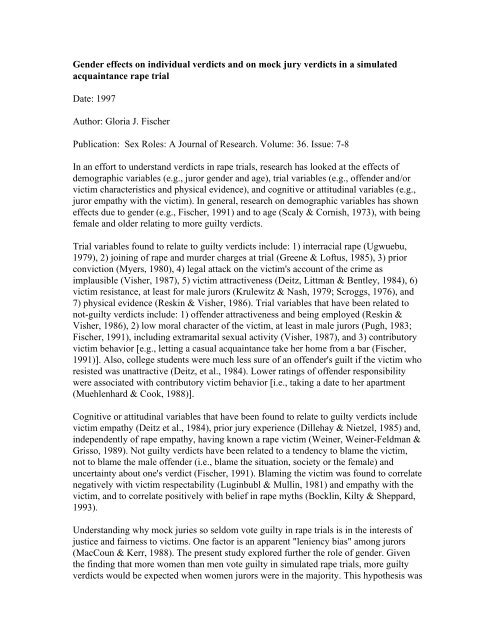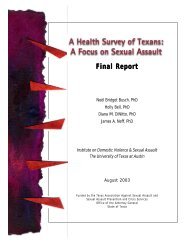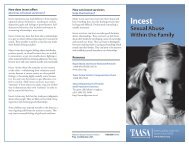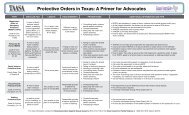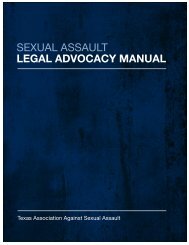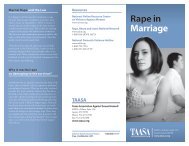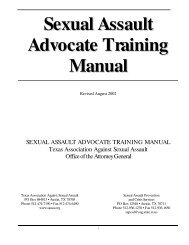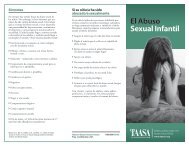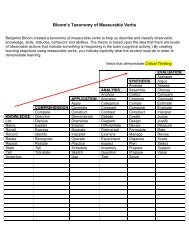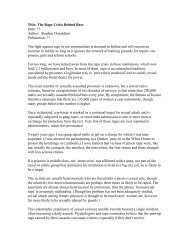Gender effects on individual verdicts and on mock jury verdicts in a ...
Gender effects on individual verdicts and on mock jury verdicts in a ...
Gender effects on individual verdicts and on mock jury verdicts in a ...
You also want an ePaper? Increase the reach of your titles
YUMPU automatically turns print PDFs into web optimized ePapers that Google loves.
<str<strong>on</strong>g>Gender</str<strong>on</strong>g> <str<strong>on</strong>g>effects</str<strong>on</strong>g> <strong>on</strong> <strong><strong>in</strong>dividual</strong> <strong>verdicts</strong> <strong>and</strong> <strong>on</strong> <strong>mock</strong> <strong>jury</strong> <strong>verdicts</strong> <strong>in</strong> a simulated<br />
acqua<strong>in</strong>tance rape trial<br />
Date: 1997<br />
Author: Gloria J. Fischer<br />
Publicati<strong>on</strong>: Sex Roles: A Journal of Research. Volume: 36. Issue: 7-8<br />
In an effort to underst<strong>and</strong> <strong>verdicts</strong> <strong>in</strong> rape trials, research has looked at the <str<strong>on</strong>g>effects</str<strong>on</strong>g> of<br />
demographic variables (e.g., juror gender <strong>and</strong> age), trial variables (e.g., offender <strong>and</strong>/or<br />
victim characteristics <strong>and</strong> physical evidence), <strong>and</strong> cognitive or attitud<strong>in</strong>al variables (e.g.,<br />
juror empathy with the victim). In general, research <strong>on</strong> demographic variables has shown<br />
<str<strong>on</strong>g>effects</str<strong>on</strong>g> due to gender (e.g., Fischer, 1991) <strong>and</strong> to age (Scaly & Cornish, 1973), with be<strong>in</strong>g<br />
female <strong>and</strong> older relat<strong>in</strong>g to more guilty <strong>verdicts</strong>.<br />
Trial variables found to relate to guilty <strong>verdicts</strong> <strong>in</strong>clude: 1) <strong>in</strong>terracial rape (Ugwuebu,<br />
1979), 2) jo<strong>in</strong><strong>in</strong>g of rape <strong>and</strong> murder charges at trial (Greene & Loftus, 1985), 3) prior<br />
c<strong>on</strong>victi<strong>on</strong> (Myers, 1980), 4) legal attack <strong>on</strong> the victim's account of the crime as<br />
implausible (Visher, 1987), 5) victim attractiveness (Deitz, Littman & Bentley, 1984), 6)<br />
victim resistance, at least for male jurors (Krulewitz & Nash, 1979; Scroggs, 1976), <strong>and</strong><br />
7) physical evidence (Resk<strong>in</strong> & Visher, 1986). Trial variables that have been related to<br />
not-guilty <strong>verdicts</strong> <strong>in</strong>clude: 1) offender attractiveness <strong>and</strong> be<strong>in</strong>g employed (Resk<strong>in</strong> &<br />
Visher, 1986), 2) low moral character of the victim, at least <strong>in</strong> male jurors (Pugh, 1983;<br />
Fischer, 1991), <strong>in</strong>clud<strong>in</strong>g extramarital sexual activity (Visher, 1987), <strong>and</strong> 3) c<strong>on</strong>tributory<br />
victim behavior [e.g., lett<strong>in</strong>g a casual acqua<strong>in</strong>tance take her home from a bar (Fischer,<br />
1991)]. Also, college students were much less sure of an offender's guilt if the victim who<br />
resisted was unattractive (Deitz, et al., 1984). Lower rat<strong>in</strong>gs of offender resp<strong>on</strong>sibility<br />
were associated with c<strong>on</strong>tributory victim behavior [i.e., tak<strong>in</strong>g a date to her apartment<br />
(Muehlenhard & Cook, 1988)].<br />
Cognitive or attitud<strong>in</strong>al variables that have been found to relate to guilty <strong>verdicts</strong> <strong>in</strong>clude<br />
victim empathy (Deitz et al., 1984), prior <strong>jury</strong> experience (Dillehay & Nietzel, 1985) <strong>and</strong>,<br />
<strong>in</strong>dependently of rape empathy, hav<strong>in</strong>g known a rape victim (We<strong>in</strong>er, We<strong>in</strong>er-Feldman &<br />
Grisso, 1989). Not guilty <strong>verdicts</strong> have been related to a tendency to blame the victim,<br />
not to blame the male offender (i.e., blame the situati<strong>on</strong>, society or the female) <strong>and</strong><br />
uncerta<strong>in</strong>ty about <strong>on</strong>e's verdict (Fischer, 1991). Blam<strong>in</strong>g the victim was found to correlate<br />
negatively with victim respectability (Lug<strong>in</strong>bubl & Mull<strong>in</strong>, 1981) <strong>and</strong> empathy with the<br />
victim, <strong>and</strong> to correlate positively with belief <strong>in</strong> rape myths (Bockl<strong>in</strong>, Kilty & Sheppard,<br />
1993).<br />
Underst<strong>and</strong><strong>in</strong>g why <strong>mock</strong> juries so seldom vote guilty <strong>in</strong> rape trials is <strong>in</strong> the <strong>in</strong>terests of<br />
justice <strong>and</strong> fairness to victims. One factor is an apparent "leniency bias" am<strong>on</strong>g jurors<br />
(MacCoun & Kerr, 1988). The present study explored further the role of gender. Given<br />
the f<strong>in</strong>d<strong>in</strong>g that more women than men vote guilty <strong>in</strong> simulated rape trials, more guilty<br />
<strong>verdicts</strong> would be expected when women jurors were <strong>in</strong> the majority. This hypothesis was
tested by vary<strong>in</strong>g the number of females <strong>on</strong> <strong>mock</strong> juries <strong>in</strong> a simulated acqua<strong>in</strong>tance rape<br />
trial. Specifically, juries were composed of 0, 2, 4, 6, 8, 10 or 12 female college students.<br />
A difficulty <strong>in</strong> test<strong>in</strong>g the predicted gender effect us<strong>in</strong>g college students is that a<br />
substantial majority of students of both genders vote guilty. To address this difficulty,<br />
two factors cited as <strong>in</strong>creas<strong>in</strong>g the number of not guilty <strong>verdicts</strong>, low moral character of<br />
the victim <strong>and</strong> lett<strong>in</strong>g a casual acqua<strong>in</strong>tance take her home from a bar, were used <strong>in</strong> the<br />
simulated acqua<strong>in</strong>tance rape trial.<br />
METHOD<br />
Participants<br />
A total of 76 <strong>mock</strong> juries were formed from college student volunteers (426 women <strong>and</strong><br />
398 men) from classes <strong>in</strong> Introductory Psychology. They received class credit for<br />
participati<strong>on</strong>. Most of the students were 18 (43%) or 19 (23%) years old, with males<br />
statistically significantly older than females (mean ages = 19.3 versus 18.9). Most were<br />
white (85%), with 4% Asian, 3.2% Black, 3.2% Hispanic <strong>and</strong> 4% "Other." Nearly all<br />
(96%) were s<strong>in</strong>gle, with 37% either <strong>in</strong>, or had been <strong>in</strong> a sexual relati<strong>on</strong>ship. Most had <strong>on</strong>e<br />
or two sibl<strong>in</strong>gs (40% <strong>and</strong> 30%, respectively).<br />
Procedure<br />
Sign-up sheets with 13 spaces were posted weekly. Spaces were marked "female" or<br />
"male" for 0, 2, 4, 6, 8, 10 or 12 women <strong>and</strong> 13, 11, 9, 7, 5, 3 or 0 men, respectively.<br />
(There was an extra space for a male, as they were less likely than females to sign up <strong>and</strong><br />
to show up). The order of post<strong>in</strong>g groups (number of females <strong>on</strong> the <strong>jury</strong>) was r<strong>and</strong>om,<br />
with the restricti<strong>on</strong> of 10 total sign-up sheets per group. Usually, two to three groups were<br />
run at the same time of day. First, all student participants were given a packet composed<br />
of a cover letter, trial <strong>and</strong> computer scantr<strong>on</strong>. For the purpose of match<strong>in</strong>g surveys <strong>and</strong><br />
scantr<strong>on</strong>s, each packet had the same group number <strong>and</strong> subject number written <strong>on</strong> both<br />
the survey <strong>and</strong> coded <strong>on</strong> the scantr<strong>on</strong>.<br />
Acqua<strong>in</strong>tance Rape Trial<br />
Follow<strong>in</strong>g Pugh (1983) <strong>and</strong> Fischer (1991), students first read summary versi<strong>on</strong>s of the<br />
alleged crime by the prosecut<strong>in</strong>g attorney <strong>and</strong> by the defense. Briefly, the prosecutor's<br />
versi<strong>on</strong> was that the pla<strong>in</strong>tiff <strong>and</strong> some female friends went to a local restaurant <strong>and</strong> bar.<br />
As there were no vacant tables, they accepted the <strong>in</strong>vitati<strong>on</strong> of a male stranger to share his<br />
table. The friends left subsequently, <strong>and</strong> when the pla<strong>in</strong>tiff was ready to leave, the<br />
accused offered to accompany her home. Once there, he requested to come <strong>in</strong> to use the<br />
bathroom, thereafter forc<strong>in</strong>g his attenti<strong>on</strong>s <strong>on</strong> her, <strong>and</strong> she asked him to leave. Instead, the<br />
accused got a knife from the kitchen <strong>and</strong>, under threats of violence, forced the victim to<br />
undress <strong>and</strong> have sexual <strong>in</strong>tercourse with him. The defense alleged that the pla<strong>in</strong>tiff was a<br />
will<strong>in</strong>g participant <strong>in</strong> sex <strong>and</strong>, as a result of fear of discovery by her roommate or<br />
boyfriend or by feel<strong>in</strong>gs of guilt, together with the accused's <strong>in</strong>sistence <strong>on</strong> rema<strong>in</strong><strong>in</strong>g <strong>and</strong><br />
a subsequent quarrel, charged him with rape <strong>and</strong> <strong>in</strong>vented the story of threaten<strong>in</strong>g her
with a knife.<br />
Next, students read excerpts from the trial transcript. These <strong>in</strong>cluded questi<strong>on</strong><strong>in</strong>g of the<br />
victim by the prosecutor <strong>and</strong> cross exam<strong>in</strong>ati<strong>on</strong> by the defense attorney. The victim's<br />
"low" moral character was suggested <strong>on</strong> cross exam<strong>in</strong>ati<strong>on</strong> by hav<strong>in</strong>g her admit to hav<strong>in</strong>g<br />
<strong>in</strong>vited her boyfriend <strong>and</strong> men she met at the pub to her apartment, but hesitat<strong>in</strong>g, then<br />
refus<strong>in</strong>g to answer the questi<strong>on</strong>: "Other than your boyfriend, have you had <strong>in</strong>tercourse<br />
with any of these other men?" until <strong>in</strong>structed to answer by the Judge <strong>and</strong> then answer<strong>in</strong>g<br />
"Yes." Third, students read the Doctor's medical report, which <strong>in</strong>dicated: "Patient was<br />
treated for m<strong>in</strong>or bruises <strong>and</strong> lacerati<strong>on</strong>s of the face <strong>and</strong> neck which were the result of an<br />
alleged rape. Evidence of sexual <strong>in</strong>tercourse was found." The medical report also said that<br />
the patient was <strong>in</strong> a state of shock, but able to talk about the <strong>in</strong>cident <strong>in</strong> some detail, <strong>and</strong><br />
that the patient was given a mild sedative <strong>in</strong>jecti<strong>on</strong>, released to her roommate, with<br />
recommendati<strong>on</strong>s of rest <strong>and</strong> referral to a Rape Crisis Center. Fourth, students read the<br />
Judge's <strong>in</strong>structi<strong>on</strong>s to the <strong>jury</strong>. Briefly, the latter described the jurors' task, expla<strong>in</strong>ed the<br />
terms "credibility" <strong>and</strong> "corroborati<strong>on</strong>" <strong>and</strong> directed that "the evidence of the two<br />
scratches <strong>on</strong> the neck of the compla<strong>in</strong>ant, as observed by friends, the police officer, <strong>and</strong><br />
the doctor, was evidence capable of amount<strong>in</strong>g to corroborati<strong>on</strong>, but whether or not it did<br />
corroborate her story is up to members of the <strong>jury</strong> to decide." The judge's <strong>in</strong>structi<strong>on</strong>s<br />
also <strong>in</strong>cluded the need for the prosecuti<strong>on</strong> to prove bey<strong>on</strong>d a reas<strong>on</strong>able doubt that the<br />
defendant did rape Nancy Lawrence <strong>and</strong>, "<strong>in</strong> the end vote <strong>in</strong> accordance with your<br />
c<strong>on</strong>science."(2) Lastly, students answered an<strong>on</strong>ymously five demographic items, then a<br />
6-item survey of their op<strong>in</strong>i<strong>on</strong>s about the trial.<br />
Trial Survey<br />
Part I of the trial-op<strong>in</strong>i<strong>on</strong> survey were the five demographic items: marital status<br />
[married, divorced, s<strong>in</strong>gle, but am (or was) <strong>in</strong> a relati<strong>on</strong>ship or s<strong>in</strong>gle], ethnicity [Native<br />
American Indian, Black American, Hispanic American, Asian American, Anglo<br />
American or Caucasian (White) or Other], number of full sibl<strong>in</strong>gs, age <strong>and</strong> gender. Part II<br />
c<strong>on</strong>sisted of the follow<strong>in</strong>g seven questi<strong>on</strong>s: (1) "In your op<strong>in</strong>i<strong>on</strong>, is the defendant guilty<br />
or not guilty?" (2) "How certa<strong>in</strong> are you about your verdict?" (very certa<strong>in</strong>, fairly certa<strong>in</strong>,<br />
not very certa<strong>in</strong>, or very uncerta<strong>in</strong>), (3) If you were the judge at the trial, <strong>and</strong> the <strong>jury</strong><br />
found the defendant guilty, which of the follow<strong>in</strong>g sentences would you choose?<br />
(Probati<strong>on</strong>, less than <strong>on</strong>e year, 1-5 years, 5-10 years, 10-20 years, more than 20 years), (4)<br />
"How important do you th<strong>in</strong>k the behavior of the victim was <strong>in</strong> c<strong>on</strong>tribut<strong>in</strong>g to the alleged<br />
assault?" (very important, somewhat important, not sure, somewhat unimportant, very<br />
unimportant), (5) "How would you rate the degree to which the alleged assault was the<br />
victim's own fault?" (not at all, somewhat, as much her fault as his, mostly, totally), (6)<br />
"How would your rate the fault or resp<strong>on</strong>sibility of the defendant <strong>in</strong> committ<strong>in</strong>g the<br />
assault?" (totally, mostly, somewhat, neutral, not at all), <strong>and</strong> (7) "How important do you<br />
th<strong>in</strong>k the c<strong>on</strong>sumpti<strong>on</strong> of alcohol was <strong>in</strong> c<strong>on</strong>tribut<strong>in</strong>g to the alleged assault?" (very<br />
important, somewhat important, not sure, somewhat unimportant, very unimportant).<br />
Mock Juries
After complet<strong>in</strong>g the trial survey, each student was asked to move to a circle of chairs<br />
with others <strong>in</strong> their preassigned (number of females) group, to be a juror. This was not<br />
always the group they had signed up for. For example, <strong>on</strong>ly 8 men may have signed up<br />
for a group of 2 women <strong>and</strong> 10 men. A sec<strong>on</strong>d group <strong>on</strong> the same day, at the same time,<br />
was 8 women <strong>and</strong> 4 men, <strong>and</strong> a third group was 4 women <strong>and</strong> 8 men. If a total of 17 men<br />
<strong>and</strong> 13 women showed up, we ran two real groups as best we could, e.g., 2 women <strong>and</strong> 9<br />
men <strong>and</strong> 4 women <strong>and</strong> 8 men. The rema<strong>in</strong><strong>in</strong>g 7 women sat as a <strong>jury</strong>, but were not counted<br />
as a <strong>jury</strong>. (The smallest sized <strong>jury</strong> counted was 10, e.g., 10 men). The first pers<strong>on</strong> to<br />
f<strong>in</strong>ish <strong>in</strong> each group was asked by the experimenter to be the forepers<strong>on</strong> <strong>on</strong> the <strong>jury</strong>. (This<br />
was d<strong>on</strong>e to save time <strong>and</strong> to maximize the time available to jurors to try to reach a<br />
verdict). They were told this would <strong>in</strong>volve their tell<strong>in</strong>g the group that they would have to<br />
try to reach a unanimous verdict, like a <strong>jury</strong>. First, the forepers<strong>on</strong> would ask every<strong>on</strong>e to<br />
write their verdict <strong>on</strong> a piece of paper, fold it <strong>and</strong> pass it to her/him. If not unanimous,<br />
then the forepers<strong>on</strong> was asked to announce the vote, <strong>and</strong> then lead a discussi<strong>on</strong><br />
prelim<strong>in</strong>ary to a sec<strong>on</strong>d ballot <strong>and</strong>, if necessary, a third. The forepers<strong>on</strong> was given a copy<br />
of the trial <strong>and</strong> told to c<strong>on</strong>sult it if jurors couldn't recall, recalled <strong>in</strong>correctly or disagreed<br />
about facts <strong>in</strong> the case.<br />
If, after three ballots, there was no unanimous verdict, <strong>and</strong> there was no change from the<br />
sec<strong>on</strong>d to third ballots, then the experimenter asked the jurors if any<strong>on</strong>e vot<strong>in</strong>g "guilty"<br />
would, no matter how l<strong>on</strong>g the <strong>jury</strong> took, never change their vote; <strong>and</strong> the same was<br />
asked of those vot<strong>in</strong>g "not guilty." If at least <strong>on</strong>e pers<strong>on</strong> <strong>in</strong> each category <strong>in</strong>dicated they<br />
would never change their vote, the <strong>jury</strong> was judged to be hung. Otherwise, they were<br />
asked to engage <strong>in</strong> another discussi<strong>on</strong> <strong>and</strong> vote, which was the last vote. When the verdict<br />
either was unanimous or hung, then written feedback as to the purpose of the experiment<br />
was passed around to be read <strong>and</strong> discussed.<br />
RESULTS<br />
<str<strong>on</strong>g>Gender</str<strong>on</strong>g><br />
Based <strong>on</strong> the f<strong>in</strong>d<strong>in</strong>g that more females than males vote guilty <strong>in</strong> simulated rape trials<br />
(Fischer, 1991), it was hypothesized that the number of guilty <strong>verdicts</strong> would <strong>in</strong>crease as<br />
a functi<strong>on</strong> of the number of women <strong>on</strong> the <strong>jury</strong>, at least <strong>on</strong>ce women were a majority. As<br />
a first test of this hypothesis, the expected gender effect <strong>on</strong> <strong><strong>in</strong>dividual</strong> <strong>verdicts</strong> was<br />
assessed. This was d<strong>on</strong>e us<strong>in</strong>g a logistic regressi<strong>on</strong> of five demographic variables<br />
(gender, marital status, ethnicity, age, <strong>and</strong> number of sibl<strong>in</strong>gs) <strong>and</strong> their sec<strong>on</strong>d order<br />
<strong>in</strong>teracti<strong>on</strong>s <strong>on</strong> guilty <strong>verdicts</strong>. This model classified <strong>on</strong>ly 66.8% of <strong>verdicts</strong> correctly,<br />
with gender <strong>and</strong> the gender by sibl<strong>in</strong>gs <strong>in</strong>teracti<strong>on</strong> the <strong>on</strong>ly statistically significant <str<strong>on</strong>g>effects</str<strong>on</strong>g><br />
(logl = 3.15, SE = 1.45, p [less than] .05; logl = 0.34, SE = 0.06; p [less than] .05,<br />
respectively). As expected, more women than men voted guilty, i.e., 86% of the 426<br />
females versus 66% of the 398 males. Also, males (but not females) from smaller families<br />
(e.g., 2 or fewer sibl<strong>in</strong>gs) were somewhat more likely to vote guilty than males from<br />
larger families.<br />
Table I summarizes data relat<strong>in</strong>g to the hypothesis that the number of guilty <strong>verdicts</strong>
would <strong>in</strong>crease when females <strong>on</strong> a <strong>jury</strong> were <strong>in</strong> the majority. As can be seen <strong>in</strong> Table I, a<br />
l<strong>in</strong>ear hypothesis can be rejected. Guilty <strong>verdicts</strong> did not <strong>in</strong>crease significantly until<br />
females either were an overwhelm<strong>in</strong>g majority (i.e., 10 out of 12) or the entire <strong>jury</strong> was<br />
female. [The percent of guilty <strong>verdicts</strong> for the 0 through 6 females <strong>on</strong> the <strong>jury</strong>, taken<br />
together, did not differ significantly from the 8 female group. However. the percent of<br />
guilty <strong>verdicts</strong> for the 0 through 8 female groups, taken together (.21) was significantly<br />
less than the percent guilty <strong>verdicts</strong> for both the 10 <strong>and</strong> 12 female groups [(e.g., for 0-8<br />
females versus 12 females: [[Chi].sup.2](1) = 5.33; p [less than] .05]. In Table I, the<br />
bottom row <strong>in</strong>dicates the number of hung juries <strong>in</strong> which a majority voted not guilty.<br />
Note that when women were a majority of jurors, there ceased to be even <strong>on</strong>e case <strong>in</strong><br />
which a majority of jurors <strong>in</strong> a "hung" <strong>jury</strong> voted not guilty.<br />
Though gender had an effect <strong>on</strong> <strong>jury</strong> <strong>verdicts</strong> (i.e., a very large majority of women or an<br />
all female <strong>jury</strong> <strong>in</strong>creased the probability of a guilty <strong>jury</strong> verdict), the probability of a<br />
guilty <strong>jury</strong> verdict (.58 <strong>and</strong> .55, respectively) was not very high (see Table I). Indeed,<br />
these probabilities are substantially [TABULAR DATA FOR TABLE I OMITTED]<br />
lower than expected probabilities based <strong>on</strong> <strong><strong>in</strong>dividual</strong> female <strong>and</strong> male percentages of<br />
guilty <strong>verdicts</strong> (i.e., 86% <strong>and</strong> 66% <strong>in</strong> women <strong>and</strong> men, respectively). For 10 female <strong>and</strong><br />
all female juries, for example, the expected probability of guilty <strong>verdicts</strong> would be .83<br />
<strong>and</strong> .86, respectively. One reas<strong>on</strong> obta<strong>in</strong>ed probabilities were so much lower than these<br />
expected probabilities probably was that, more often than not, the <strong>on</strong>e or more <strong><strong>in</strong>dividual</strong>s<br />
<strong>on</strong> a <strong>jury</strong> vot<strong>in</strong>g not guilty (mostly males), stuck with it.<br />
As a first approximati<strong>on</strong> of why gender related to guilty <strong>verdicts</strong>, <strong>in</strong>tercorrelati<strong>on</strong>s<br />
(Pears<strong>on</strong>s rs) am<strong>on</strong>g gender, guilty verdict <strong>and</strong> the six trial survey variables were<br />
calculated. Table II shows <strong>on</strong>ly the statistically significant correlati<strong>on</strong>s that were found.<br />
As can be seen from Table II, correlati<strong>on</strong>s between gender <strong>and</strong> trial variables were<br />
uniformly smaller than correlati<strong>on</strong>s between (guilty) verdict <strong>and</strong> trial variables,<br />
suggest<strong>in</strong>g that gender would not add significantly to predicti<strong>on</strong> of <strong>verdicts</strong> over use of<br />
trial variables al<strong>on</strong>e.<br />
Attitud<strong>in</strong>al <strong>and</strong> Trial Variables<br />
Fischer (1991) found attitud<strong>in</strong>al variables, such as the juror's certa<strong>in</strong>ty of verdict, <strong>and</strong>,<br />
especially, blam<strong>in</strong>g of the victim, were better predictors of [TABULAR DATA FOR<br />
TABLE II OMITTED] not-guilty <strong>verdicts</strong> than either their sexual attitudes <strong>and</strong><br />
experience <strong>and</strong>/or demographics. To assess the role of these <strong>and</strong> other attitud<strong>in</strong>al <strong>and</strong> trial<br />
variables measured here, (i.e., certa<strong>in</strong>ty of verdict, sentence, victim fault, offender fault,<br />
victim behavior as c<strong>on</strong>tributory to the rape <strong>and</strong> alcohol use as c<strong>on</strong>tributory to the rape) a<br />
sec<strong>on</strong>d logistic regressi<strong>on</strong> model, with classificati<strong>on</strong> table, regressed these six variables<br />
<strong>and</strong> all sec<strong>on</strong>d order <strong>in</strong>teracti<strong>on</strong>s <strong>on</strong> not-guilty <strong>verdicts</strong>. This model classified 85% of<br />
<strong><strong>in</strong>dividual</strong> student <strong>verdicts</strong> correctly. When gender <strong>and</strong> its <strong>in</strong>teracti<strong>on</strong>s with the six<br />
variables were added to the model, 87% of cases were classified correctly. However,<br />
neither gender nor any of its <strong>in</strong>teracti<strong>on</strong> <str<strong>on</strong>g>effects</str<strong>on</strong>g> was statistically significant. Statistically<br />
significant comp<strong>on</strong>ents of the model were: Certa<strong>in</strong>ty of Verdict, CER (logl = 5.38, SE =<br />
1.38, p [less than] .01); CER x Victim Fault, VF (logl = 1.02, SE = 0.30. p [less than]
.01), VF x Victim Behavior C<strong>on</strong>tributory, VB (logl = 0.37, SE = 0.18, p [less than] .05),<br />
VB x Offender Fault, OF (logl = -0.46, SE = 0.20, p [less than] .05), <strong>and</strong> VB x Sentence<br />
(logl = 0.22, SE = 0. 11, p [less than] .05). As found previously (Fischer, 1991),<br />
uncerta<strong>in</strong>ty about a verdict <strong>in</strong>creased the probability of a not guilty verdict (i.e., very<br />
certa<strong>in</strong> = .03, fairly certa<strong>in</strong> = .29, fairly uncerta<strong>in</strong> = .42, <strong>and</strong> very uncerta<strong>in</strong> = .50). The<br />
nature of the CER x VF (certa<strong>in</strong>ty of verdict by victim fault) <strong>in</strong>teracti<strong>on</strong> was that students<br />
vot<strong>in</strong>g guilty were most likely to blame the victim somewhat or not at all, <strong>and</strong> they were<br />
fairly- to very certa<strong>in</strong> of their verdict. Students vot<strong>in</strong>g not guilty, <strong>on</strong> the other h<strong>and</strong>, were<br />
more likely to blame the victim more (i.e., somewhat or as much as the offender) <strong>and</strong> to<br />
be less certa<strong>in</strong> (fairly certa<strong>in</strong> to somewhat uncerta<strong>in</strong>) of their verdict.<br />
To underst<strong>and</strong> the VB x VF <strong>in</strong>teracti<strong>on</strong> note, first of all, that no student who judged the<br />
c<strong>on</strong>tributi<strong>on</strong> of the victim's behavior to the alleged assault to be unimportant blamed the<br />
victim as much as, or more than the male. That is, such comb<strong>in</strong>ati<strong>on</strong>s simply did not<br />
occur. As noted previously, most students judged the victim's behavior to have been an<br />
important c<strong>on</strong>tributor to what happened. When these students also blamed the victim as<br />
much as, or more than the male, a not guilty verdict was very much more likely than<br />
when they blamed the victim somewhat or not at all. Indeed, am<strong>on</strong>g students who were<br />
"not sure," or who c<strong>on</strong>sidered the victim's behavior an important c<strong>on</strong>tributor to the<br />
alleged assault, 68% voted not guilty if they also blamed the victim as much as, or more<br />
than the male, while <strong>on</strong>ly 20% voted not guilty if they judged the victim to be no more<br />
than somewhat at fault.<br />
The nature of the VB x OF (victim's behavior c<strong>on</strong>tributory by offender fault) <strong>in</strong>teracti<strong>on</strong><br />
was as follows: The probability of blam<strong>in</strong>g the offender totally was .80, <strong>and</strong> most others<br />
who voted guilty blamed the offender mostly. Most of these students judged the victim's<br />
behavior to have been a somewhat important, or even a very important c<strong>on</strong>tributor to<br />
what happened. Most students vot<strong>in</strong>g not guilty, <strong>on</strong> the other h<strong>and</strong>, judged the offender<br />
mostly at fault, rather than totally, <strong>and</strong> tended to judge the victim's behavior to have been<br />
a more important c<strong>on</strong>tributor to the alleged assault, (i.e., a very important, or, at least, a<br />
somewhat important c<strong>on</strong>tributor). In other words, not-guilty votes were associated with<br />
blam<strong>in</strong>g the offender less than the victim's behavior was judged c<strong>on</strong>tributory, while guilty<br />
votes were associated with blam<strong>in</strong>g the offender more, irrespective of how c<strong>on</strong>tributory<br />
victim's behavior was judged. The nature of the VB x SEN (victim behavior c<strong>on</strong>tributory<br />
by sentence) <strong>in</strong>teracti<strong>on</strong> was that students vot<strong>in</strong>g guilty tended to choose a 5-10 year<br />
sentence if they judged the victim's behavior to have been unimportant <strong>in</strong> the alleged<br />
assault, but chose a lighter sentence (i.e., 1-5 years) if they judged the victim's behavior to<br />
have been an important c<strong>on</strong>tributor. Students vot<strong>in</strong>g not-guilty, <strong>on</strong> the other h<strong>and</strong>, chose a<br />
lighter sentence, regardless of how c<strong>on</strong>tributory they judged the victim's behavior.<br />
DISCUSSION<br />
Even though substantially more females (86%) than males (66%) voted guilty<br />
<strong><strong>in</strong>dividual</strong>ly, the number of guilty <strong>mock</strong> <strong>jury</strong> <strong>verdicts</strong> <strong>in</strong>creased significantly <strong>and</strong><br />
substantially <strong>on</strong>ly if the number of females <strong>on</strong> the <strong>jury</strong> were a huge majority (i.e., 10<br />
females to 2 males) or if the <strong>jury</strong> was all female. Even <strong>in</strong> the latter two groups, however,
<strong>on</strong>ly 56% of <strong>mock</strong> <strong>jury</strong> <strong>verdicts</strong> were guilty <strong>verdicts</strong>. Though p = .56 was more than twice<br />
the mean percent guilty votes <strong>in</strong> other <strong>mock</strong> <strong>jury</strong> groups, taken together (p = .24), p = .56<br />
is substantially less than expected frequencies, based <strong>on</strong> <strong><strong>in</strong>dividual</strong> guilty <strong>and</strong> not guilty<br />
<strong>verdicts</strong> (i.e., .82 <strong>in</strong> the 10 females to 2 males group <strong>and</strong> .86 <strong>in</strong> the all female <strong>jury</strong> group).<br />
A likely reas<strong>on</strong> is that, some students vot<strong>in</strong>g guilty, were not "very certa<strong>in</strong>" of their<br />
verdict <strong>and</strong> thus could be <strong>in</strong>fluenced by other jurors, accord<strong>in</strong>gly. Also, much more often<br />
than not, at least <strong>on</strong>e of the pers<strong>on</strong>s vot<strong>in</strong>g not guilty, who were mostly male, held out,<br />
result<strong>in</strong>g <strong>in</strong> a hung <strong>jury</strong>. In additi<strong>on</strong> to the f<strong>in</strong>d<strong>in</strong>g that an overwhelm<strong>in</strong>g majority of<br />
women jurors <strong>in</strong>creased the probability of a guilty <strong>mock</strong> <strong>jury</strong> verdict, another gender<br />
effect occurred when females were a majority of jurors. Specifically, when women jurors<br />
were <strong>in</strong> the majority, no "hung" <strong>jury</strong> had a majority of jurors vot<strong>in</strong>g not guilty. In<br />
c<strong>on</strong>trast, all hung juries composed of six or fewer women jurors had at least <strong>on</strong>e <strong>jury</strong> <strong>in</strong><br />
which a majority voted not guilty. Thus, present f<strong>in</strong>d<strong>in</strong>gs suggest that a majority of<br />
women <strong>on</strong> a <strong>jury</strong> may obviate a not guilty <strong>jury</strong> verdict, at least, whereas a very large<br />
majority may be needed to <strong>in</strong>crease the likelihood of a guilty <strong>jury</strong> verdict, even though<br />
these guilty <strong>verdicts</strong> still occur <strong>on</strong>ly a little more than half the time.<br />
Tend<strong>in</strong>g not to blame the victim <strong>and</strong> tend<strong>in</strong>g to blame the offender were str<strong>on</strong>ger<br />
predictors of guilty <strong>verdicts</strong> than be<strong>in</strong>g female, because the former <strong>in</strong>cluded most<br />
females, but was not restricted to them. The implicati<strong>on</strong> is that guilty <strong>jury</strong> <strong>verdicts</strong> <strong>in</strong> a<br />
rape trial are more likely if <strong><strong>in</strong>dividual</strong> jurors tend not to blame the victim <strong>and</strong> tend to<br />
blame the offender. If such <strong>in</strong>formati<strong>on</strong> is not available, however, then gender al<strong>on</strong>e (i.e.,<br />
at least half of the <strong>jury</strong> female) may decrease the likelihood of a not guilty verdict, but<br />
may not <strong>in</strong>crease the likelihood of a guilty verdict, unless women are an overwhelm<strong>in</strong>g<br />
majority (i.e., 10 out of 12 or all 12). Of course, present f<strong>in</strong>d<strong>in</strong>gs <strong>and</strong> suggested<br />
<strong>in</strong>terpretati<strong>on</strong>s may be limited to the rape scenario used here <strong>and</strong>, perhaps to similar<br />
scenarios.<br />
2 The packet given to students (i.e., cover letter, trial transcript, medical report, judge's<br />
<strong>in</strong>structi<strong>on</strong>s to the <strong>jury</strong>, <strong>and</strong> Parts I <strong>and</strong> II of the trial survey) will be provided, up<strong>on</strong><br />
request.<br />
REFERENCES<br />
Bockl<strong>in</strong>, A., Kilty, M. & Sheppard, J. A. (1993, April). Predictors <strong>and</strong> c<strong>on</strong>sequences of<br />
victim blam<strong>in</strong>g. Paper presented at the meet<strong>in</strong>gs of the Midwestern Psychological<br />
Associati<strong>on</strong>, Chicago, IL.<br />
Deitz, S. R., Littman, M., & Bentley, B. J. (1984). Attributi<strong>on</strong> of resp<strong>on</strong>sibility for rape:<br />
The <strong>in</strong>fluence of observer empathy, victim resistance, <strong>and</strong> victim attractiveness. Sex<br />
Roles, 10.<br />
Dillehay, R. C., & Nietzel, M. T. (1985). Juror experience <strong>and</strong> <strong>jury</strong> <strong>verdicts</strong>. Law <strong>and</strong><br />
Human Behavior, 9, 179-191.<br />
Fischer, G. J. (1991). Cognitive predictors of not-guilty <strong>verdicts</strong> <strong>in</strong> a simulated
acqua<strong>in</strong>tance rape trial. Psychological Reports, 68, 1199-1206.<br />
Greene, E., & Loftus, E. F. (1985). When crimes are jo<strong>in</strong>ed at trial. Law <strong>and</strong> Human<br />
Behavior, 2, 193-207.<br />
Krulewitz, J. E., & Nash, J. E. (1979). Effects of rape victim resistance, assault outcome,<br />
<strong>and</strong> sex of observer <strong>on</strong> attributi<strong>on</strong>s about rape. Journal of Pers<strong>on</strong>ality, 47, 558-574.<br />
Lug<strong>in</strong>buhl, J., & Mull<strong>in</strong>, C. (1981). Rape <strong>and</strong> resp<strong>on</strong>sibility: How <strong>and</strong> how much is the<br />
victim blamed? Sex Roles, 7, 547-559.<br />
MacCoun, R. J., & Kerr, N. L. (1988). Asymmetric <strong>in</strong>fluence <strong>in</strong> <strong>mock</strong> <strong>jury</strong> deliberati<strong>on</strong>:<br />
Juror's bias for leniency. Journal of Pers<strong>on</strong>ality <strong>and</strong> Social Psychology, 54, 21-33.<br />
Muehlenhard, C. L., & Cook, S. W. (1988). Men's self-reports of unwanted sexual<br />
activity. Journal of Sex Research, 24, 58-72.<br />
Myers, M. A. (1980). Social c<strong>on</strong>texts <strong>and</strong> attributi<strong>on</strong>s of crim<strong>in</strong>al resp<strong>on</strong>sibility. Social<br />
Psychology Quarterly, 43, 405-419.<br />
Pugh, M.D. (1983). C<strong>on</strong>tributory fault <strong>and</strong> rape c<strong>on</strong>victi<strong>on</strong>s: Logl<strong>in</strong>ear models for<br />
blam<strong>in</strong>g the victim. Social Psychology Quarterly, 46, 233-242.<br />
Resk<strong>in</strong>, B. F., & Visher, C. A. (1986). The impacts of evidence <strong>and</strong> extralegal factors <strong>in</strong><br />
jurors' decisi<strong>on</strong>s. Law <strong>and</strong> Society Review, 9, 423-437.<br />
Scroggs, J. R. (1976). Penalties for rape as a functi<strong>on</strong> of victim provocativeness, damage,<br />
<strong>and</strong> resistance. Journal of Applied Psychology, 6, 360-368.<br />
Sealy, A., & Cornish, W. (1973). Jurors <strong>and</strong> their <strong>verdicts</strong>. Modern Law Review, 36,<br />
496-508.<br />
Ugwuebu, D.C. E. (1979). Racial <strong>and</strong> evidential factors <strong>in</strong> juror attributi<strong>on</strong> of legal<br />
resp<strong>on</strong>sibility. Journal of Experimental Social Psychology, 15, 133-146.<br />
Visher, C. (1987). Juror decisi<strong>on</strong> mak<strong>in</strong>g: The importance of evidence. Law <strong>and</strong> Human<br />
Behavior, 11, 1-17.<br />
We<strong>in</strong>er, R. L., We<strong>in</strong>er-Feldman, A. T., & Grisso, T. (1989). Empathy <strong>and</strong> biased<br />
assimilati<strong>on</strong> of testim<strong>on</strong>ies <strong>in</strong> cases of alleged rape. Law <strong>and</strong> Human Behavior, 13,<br />
343-355.<br />
Weir, J. A., & Wrightsman, L. S. (1988, April). The determ<strong>in</strong>ants of <strong>mock</strong> jurors' <strong>verdicts</strong><br />
<strong>in</strong> a rape case. Paper presented at meet<strong>in</strong>gs of the Midwestern Psychological Associati<strong>on</strong>,<br />
Chicago, IL.


